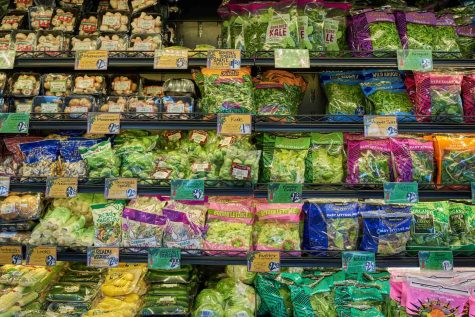Peck: Our food system tells us why groceries are so expensive
February 21, 2023
Editor’s Note: All opinion section content reflects the views of the individual author only and does not represent a stance taken by The Collegian or its editorial board.
If you’ve shopped at any grocery store recently, you’ve probably noticed the ridiculous inflation of prices of everyday food items like eggs, milk and bread. A quick stop at any store for a few items can easily turn into an expensive ordeal. It feels like forever since I have been able to keep the bill under $20.
The issue affects people nationwide, with the average American spending an extra $72.01 a month on food. Many people are feeling the strain on their finances and are forced to be more frugal with their purchases.
Many factors, including geo-political conflicts, weather patterns and disease, are contributing to the rise in prices.
The war in Ukraine has caused billions of dollars worth of damage to farmland and made transporting crops more difficult, causing bread prices to soar. Extreme heat waves and droughts in Spain have devastated olive crops and reduced expected harvests by 50%.
Almost all fresh fruits and vegetables grown in California have seen a rapid increase in price due to dry weather conditions and disease. Lettuce has been the most affected because much of the harvest was damaged by an insect-borne virus.
However, the food item with the most outrageous price increase is eggs, which rose to an average of $4.25 per dozen in December 2022 and are even more expensive now as the issue has yet to resolve. This is partially due to the spread of the avian influenza virus, which has infected more than 58 million chickens in the United States.
“The food industry functions as a lens to view the financial and cultural state of our communities by helping us understand how the systems and structures imposed on us affect our day-to-day lives. When these systems impede our livelihood rather than advance it, we must reconsider the manner in which we partake in them.”
While the decreasing supply of eggs is certainly a factor, price gouging from large corporations has escalated the problem.
“There is something called the four-firm concentration ratio, and that refers to the degree to which any sector is concentrated, and it is a way of measuring how anti-competitive a particular sector is,” said Joshua Sbicca, an associate professor of sociology at Colorado State University who studies food systems and culture. “For example, in chicken processing, it’s got a four-firm concentration ratio of 54%, which would be considered highly concentrated and almost significantly distorted.”
Because only a few corporations control the majority of the chicken industry, they can set prices as high as they want due to a lack of competition. While attempts have been made to implement regulations to prevent price gouging, almost nothing has been successful.

In a time when financial insecurity is relevant for many people, a select few companies have seen record profits.
“Sixty-two new food billionaires were created during the pandemic,” Sbicca said. “Global food prices have surged 65% since the start of the pandemic until now.”
The food industry functions as a lens to view the financial and cultural state of our communities by helping us understand how the systems and structures imposed on us affect our day-to-day lives. When these systems impede our livelihood rather than advance it, we must reconsider the manner in which we partake in them.
In terms of food, corporate grocery stores are designed to provide affordability and convenience. If they cannot provide this, then we are forced to get creative with how we shop. This could include buying in bulk or shopping locally.
Something needs to be done because unnecessary increases in grocery prices are the last thing we all need. For those who are struggling to find their next meal, there are local food pantries that can help relieve some of the strain.
We can hope prices eventually go back to normal in the coming year. But as of right now, grocery prices are out of control, and I need some milk money.
Reach Aaron Peck at letters@collegian.com or on Twitter @Aa_peck7.







